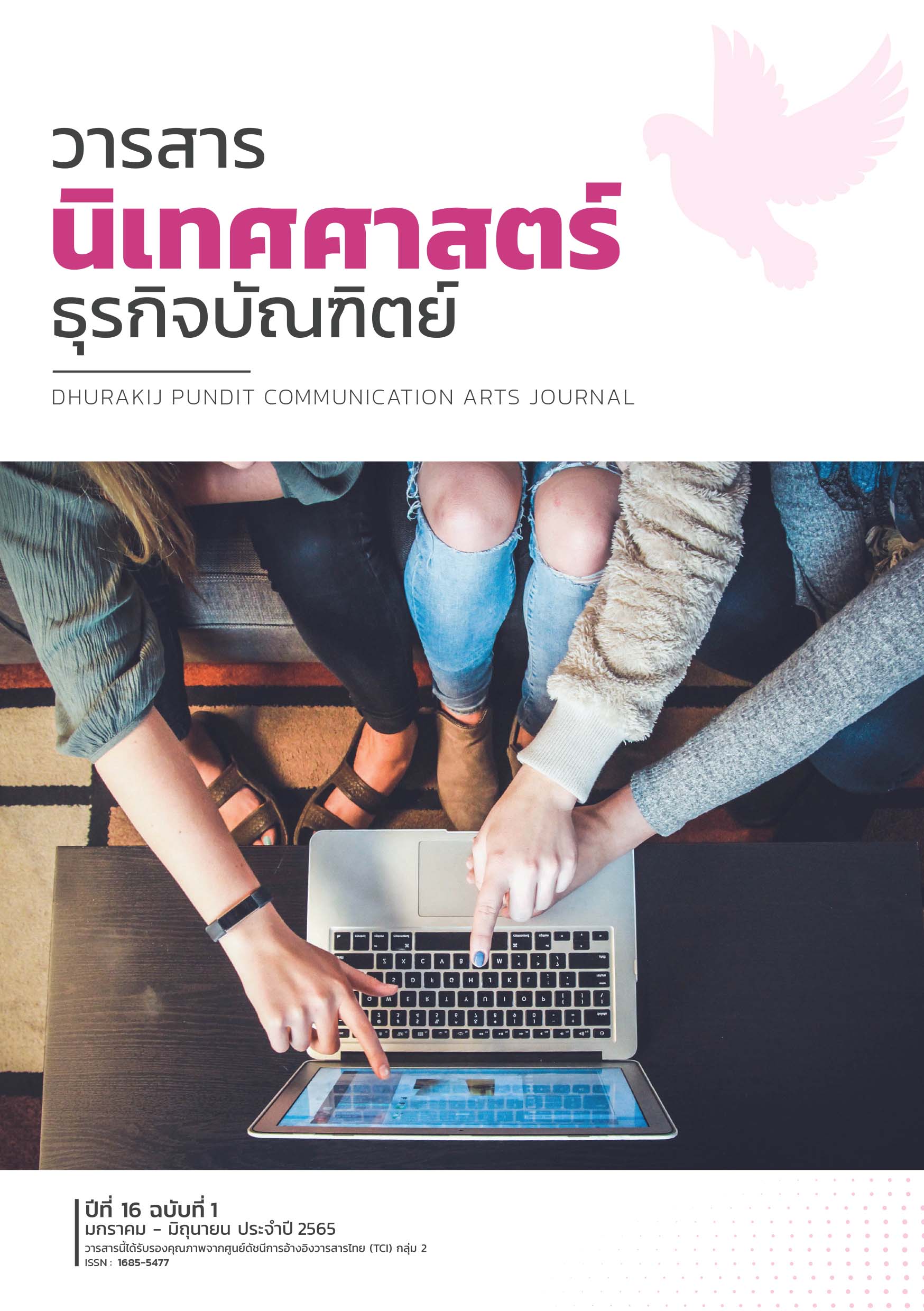การสื่อสารการตลาดแบบบูรณาการกับการสร้างชุมชนแบรนด์เกมความเป็นจริงเสริม (เออาร์) ในประเทศไทย
คำสำคัญ:
การสื่อสารการตลาดแบบบูรณาการ, ชุมชนแบรนด์, ชุมชนตราสินค้า, เกมความเป็นจริงเสริม, เกมเออาร์บทคัดย่อ
การวิจัยครั้งนี้มีวัตถุประสงค์เพื่อศึกษากลยุทธ์การสื่อสารการตลาดแบบบูรณาการของแบรนด์เกมความเป็นจริงเสริม (เออาร์) ความเป็นชุมชนแบรนด์ และอิทธิพลของกลยุทธ์การสื่อสารการตลาดแบบบูรณาการที่มีต่อชุมชนแบรนด์ โดยมีระเบียบวิธีวิจัยประกอบด้วย การวิเคราะห์ข้อมูลจากเอกสาร การสัมภาษณ์แบบเจาะลึกกับนักสื่อสารการตลาด ผู้บริหารองค์กรธุรกิจ ตลอดจนนักวิชาการด้านเกม และผู้ดูแลชุมชนแบรนด์จำนวน 24 คน ในส่วนการวิจัยเชิงสำรวจใช้แบบสอบถามกับสมาชิกในชุมชนแบรนด์เกมความเป็นจริงเสริมได้แก่ เกมโปเกมอน โก และแฮรี่ พอตเตอร์ วิซาร์ด ยูไนท์ จำนวน 400 คน ผลการวิจัยพบว่าแบรนด์เกมความเป็นจริงเสริมใช้กลยุทธ์การสื่อสารการการตลาดแบบบูรณาการทุกเครื่องมือ ได้แก่ การตลาดเชิงกิจกรรม การตลาดทางตรง การส่งเสริมการขาย การประชาสัมพันธ์และการโฆษณา ยกเว้นเครื่องมือการใช้พนักงานขาย ในส่วนลักษณะความเป็นชุมชนแบรนด์มีองค์ประกอบซึ่งเป็นลักษณะความเป็นชุมชนแบรนด์อย่างครบถ้วนได้แก่ การมีความรู้สึกเป็นพวกเดียวกัน การมีแบบแผน/ประเพณีที่เป็นวัฒนธรรมของกลุ่มและการมีความรับผิดชอบต่อกลุ่มสมาชิก โดยแบรนด์เป็นสิ่งที่เชื่อมโยงสมาชิกให้มารวมกลุ่ม และกลยุทธ์การสื่อสารการตลาดแบบบูรณาการของแบรนด์มีอิทธิพลต่อการสร้างชุมชนแบรนด์เกมความเป็นจริงเสริมในทุกองค์ประกอบของชุมชนแบรนด์ยกเว้นการโฆษณาที่มีอิทธิพลน้อยมาก
เอกสารอ้างอิง
ชุลีพร จันทรางศุ. (2559). แรงจูงใจและผลกระทบที่เกิดจากการเล่นเกมส์ออนไลน์โปเกม่อนโก [จุลนิพนธ์, มหาวิทยาลัยศิลปากร].
สำนักงานปลัดกระทรวงการอุดมศึกษา วิทยาศาสตร์ วิจัยและนวัตกรรม, ศูนย์เทคโนโลยีสารสนเทศและการสื่อสาร. เทคโนโลยีโลกเสมือน VR/AR/MR. Ops. https://www.ops.go.th/main/index.php/knowledge-base/article-pr/675-interface-technology-vr-ar-mr
อริสรา ไวยเจริญ. (2558). การโฆษณากับพฤติกรรมผู้บริโภคในยุคดิจิทัล. วารสารนิเทศศาสตร์ธุรกิจบัณฑิตย์, 9(1), 11-35.
Pigabyte. (2561, 31 มกราคม). เจาะลึกพฤติกรรมการใช้อินเตอร์เน็ตของ คนไทย ม.ค. 2018 แบบละเอียดยิบ. https://www.marketingoops.com/reports/behaviors/thailand-digital-in-2018/
PeerPower Team. (2563, 19 มิถุนายน). อุตสาหกรรม “เกมไทย” 2020. PeerPower. https://www.peerpower.co.th/blog/investor/thai-game-industry/
WorkpointTODAY. (2564, 16 กุมภาพันธ์). เกมโอกาสธุรกิจใหม่มาแรง. Workpointtoday. https://workpointtoday.com/game-industry/
Aaker, D. A. (1996). Measuring brand equity across products and markets. California Management Review, 38, 102-120. https://doi.org/10.2307/41165845
Alhaa, K., Koskinena, E., Paavilainena, J., & Hamaria, J. (2019). Why do people play location-based augmented reality games: A study on Pokémon GO. Computers in Human Behavior, 93, 114-122. https://doi.org/10.1016/j.chb.2018.12.008
Alzahrani, A. L., Mahmud, I., Ramayah, T., Alfarraj, O., & Alalwan, N. (2017). Extending the theory of planned behavior (TPB) to explain online game playing among Malaysian undergraduate students. Telematics and Informatics, 34(4), 239-251. https://doi.org/10.1016/j.tele.2016.07.001
Beckmann, S. C., & Gjerløff, M. (2008). A framework for communicating with brand communities. In M. Thyne, K. R. Deans and J. Gnoth (Eds.), 3Rs - Reputation, Responsibility & Relevance, 7 (pp. 1710-1716). ANZMAC.
Dessart, L., Aldás-Manzano, J., & Veloutsou, C. (2019). Unveiling heterogeneous engagement-based loyalty in brand communities. European Journal of Marketing, 53(9), 1854-1881. https://doi.org/10.1108/EJM-11-2017-0818
Duncan, T. (2002). IMC: Using advertising and promotion to build brands. MaGraw-Hill.
Fournier, S. (1998). Consumers and their brands: Developing relationship theory in consumer research. Journal of consumer Research, 24(4), 343–373. https://doi.org/10.1086/209515
Gabbiadini, A., Sagioglou, C., & Greitemeyer, T. (2018). Does Pokemon Go lead to a more physically active life style?. Computers in Human Behavior, 8(84), 258-263. https://doi.org/10.1016/j.chb.2018.03.005
Günzel-Jensen, F., & Holm, A. B. (2017). Freemium business models as the foundation for growing an e-business venture: A multiple case study of industry leaders. Journal of Entrepreneurship, Management and Innovation, 11(1), 77-101. https://doi.org/10.7341/20151115
Kline, A. M., (2014, September 17). Failed at real-time marketing? Try right-time instead. Marketingmagazine. http://marketingmagazine.co.uk/article/1311873/
Kotler, P., & Keller, K. L. (2015). A framework for marketing management (6th ed.). Pearson.
Laetitia de Crombrugghe de Picquendaele, L. (2016). Analysis of an innovative business model: The freemium and its applications (Master’ thesis, Nova School of Business and Economics).
Lloyd, D. (2014, September 30). 6 Tips for sequencing your marketing content. Clickz. https://www.clickz.com/6-tips-for-sequencing-your-marketing-content/29451/
McAlexander, J. H., Schouten, J. W., & Koening, H. F. (2002). Building brand community. Journal of Marketing, 66(1), 38-54.
Muniz, A. M., & O’Guinn, T. (2005). Marketing communications in a world of consumption and brand communities. In A. J. Kimmel (Ed.), Marketing Communication New Approaches, Technologies and Styles (pp. 63-85). Oxford Univ. Press.
Muniz, M., & O’Guinn, C. (2001). Brand community. Journal of Consumer Research, 27(3), 412-432.
Schultz, D. E., Tannenbaum, S. I., & Lauterborn, R. F. (1993). Integrated marketing communications. NTC Business Books.
Yang, C., & Liu, D. (2017). Motives matter: Motives for playing Pokémon Go and implications for well-being. Cyberpsychology, Behavior, and Social Networking, 20(1), 52-57. https://doi.org/10.1089/cyber.2016.0562
ดาวน์โหลด
เผยแพร่แล้ว
ฉบับ
ประเภทบทความ
สัญญาอนุญาต
ลิขสิทธิ์ (c) 2022 วารสารนิเทศศาสตร์ธุรกิจบัณฑิตย์

อนุญาตภายใต้เงื่อนไข Creative Commons Attribution-NonCommercial-NoDerivatives 4.0 International License.
ลิขสิทธิ์เป็นของวารสาร....




